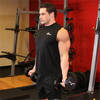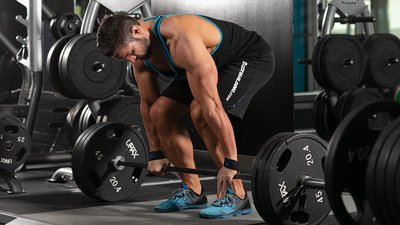If you've been training consistently for five years or more and you're not being hounded regularly to compete, model, or jump out of a cake at a party, you're probably not the second coming of Flex Wheeler.
In fact, you're probably just average.
"Average" isn't some terrible affliction. Everyone has a certain "response potential" to resistance training, and for most people, that genetic potential is just average.
There are very few Flex Wheelers out there—genetically marvels with long muscle bellies, ideal insertion points, and a higher percentage of fast-twitch fibers ideally suited to build muscle.
Of course, many people have gone far with less than ideal genetics—hard work and consistency are powerful things. While you can't change your genes, you can work with them—and even around them.
I've put together a list of the most common average-person problems, and a remedy for each.
Issue 1: I can't gain weight
Some folks are cursed with hummingbird-like metabolisms. They can pack away enormous amounts of food, then head to Vegas and lose three pounds in a weekend. Very often, these are dudes in their early 20s or younger.
The majority of mature lifters who have trouble gaining weight don't have a metabolism issue—they have a lifestyle issue.
They say they "eat a ton," but ask them to track their food and out pops the truth: They tend to skip breakfast (and no, coffee doesn't cut it), have a large lunch that keeps them full for hours, maybe swallow a workout drink, and then pound a late 1000-calorie dinner that leaves them stuffed until bed.
Crunch the math, and "eating a ton" typically lands in the mere 2000-calorie range, which really isn't that much when you're trying to gain weight.
Solution
Alternate 2-3 big, solid meals with three liquid meals. Liquid meals are ideal because you can easily suck back a quality meal-replacement product with a tablespoon of good fat or a handful of nuts added.
Do that three times a day, and that's 1500 extra muscle-building calories in less than five minutes. Not to mention, a shake makes a great, quick breakfast.
Issue 2: I gain too much fat when I gain mass
Most older people can gain weight quite easily, but it's usually more fat than muscle. The more weight they put on—despite working out—the worse the ratio seems to get.
This conundrum is thanks to less-than-ideal insulin sensitivity, a measure of how well the body metabolizes carbohydrates. Insulin sensitivity tends to decline naturally with age, so the older you get, the more uphill this battle becomes.
Solution
Leaner people tend to have better insulin sensitivity than overweight people, so the first order of business is to get lean and stay lean.
For lifters over 35 years of age, I advise against "bulking," or going on a mass-building phase. Period. A slow-and-steady approach, including lots of fiber and good fats and fewer simple carbs, is a far better approach to building mass over time while maintaining good insulin sensitivity and stable blood sugar.
The caveat is that when trying to gain muscle, you're going to need a calorie surplus and be okay with a little fat gain. Just know when to say when. Once your four-pack becomes a blurry two-fer, consider switching to a fat-loss phase.
Issue 3: When I diet, I lose as much muscle as fat
You've probably seen those people who diet for 12 weeks, lose 25 pounds, and look exactly the same, only smaller. Yikes!
Upon closer inspection of their methods, you uncover an aggressive calorie reduction and excessive amounts of exercise—basically, eating a lot less and moving a lot more. A 1000-calorie deficit and an hour of cardio a day to maintain the fat loss? In other words, these people play too many cards right out the gate.
Solution
For mature lifters, focusing on diet more than cardio results in less muscle loss and better results. Plus, cardio only further taps into your already-compromised ability to recover during a leaning phase, which can impact effective weight training for muscle retention.
If you need an extra nudge for continued fat loss, bumping up the reps and decreasing the rest intervals during your weight training works similarly to cardio, with greater retention in size and fullness.
You can always add cardio down the road if you need it for continued progress—provided you don't overdo it at the beginning.
Issue 4: I can't get a specific body part to grow
If you've been training for any decent length of time, chances are you have at least one weak body part that just won't grow.
While providing a weak-point blueprint for every body part is beyond the scope of this article, here's a crucial piece of advice: Take whatever exercises you've been doing for that body part and just stop doing them, at least for a while.
Quite frankly, your body is bored. Those exercises no longer "shock the muscles," as Arnold would say.
Solution
Throw your weaknesses a damned curveball. You can change anything, such as exercises, machines, sets, reps, and tempo. If you want to focus on one change, my suggestion is to change your frequency.
For example, if you normally have one arm day each week, switch to training biceps and triceps two or even three times a week instead.
While variety isn't as important when building strength, it's a greatly underappreciated factor in muscle growth. Mature lifters tend to get set in their ways, and if you always do the same thing, you can't suddenly expect a new result.
Issue 5: I'm strong but not big
Strength training is fun and rewarding, but intense strength training is no picnic for the joints. Furthermore, too much heavy loading is also stressful on your nervous system.
Combined with work stress, family drama, and a shitty sleep schedule, this spells a recipe for disaster.
Once you get past 35, it's not so easy to bounce back from injuries.
Solution
You just might be better suited to a lower-intensity, higher-volume approach. Yes, strength is the backbone of weight training, but volume is still the key driver of hypertrophy.
If your main goal is to get bigger, consider taking a break from heavy lifting in the 2-3-rep range and work in the 8-12-rep range—even 15-20 reps! Not only will you get bigger, your joints will love you.
Issue 6: I'm big, but I just don't look like a bodybuilder
Believe it or not, most older guys still have a lot of untapped potential to grow bigger. Or at least appear bigger.
To put it another way, a relatively "small" physique that looks more symmetrical can seem a lot more imposing than superhero shoulders paired with pipe-cleaner calves. For example, a developed set of rear delts gives the whole physique a more 3-D look while also making the triceps look bigger. Developed forearms and calves are like a cake's icing on an otherwise burly physique.
Solution
To achieve the illusory appearance of being bigger than you might actually be, your program foundation should include big, compound exercises that hit muscle groups of varying sizes. It should also include plenty of isolation exercises such as bicep curls, lateral raises, calf raises, and triceps push-downs. These bring your lagging body parts more up to speed.
In fact, throw the works on them: Exercise variety, supersets, giant sets, dropsets, rest pauses—the entire kitchen sink that gives them no choice but to grow. There are endless ways to do this. To get you started, I've included a sample arm workout for you to try.



BodyFit
$6.99/month- 2,500+ expert-created single workouts
- 3,500+ how-to exercise videos
- Detailed workout instruction
- Step-by-step workout tips
- Training at gym or at home
- Access to Workout Plans
- Access to Bodyfit App
- Store Discounts
Already have a Bodybuilding.com account with BodyFit? Sign In

What comes with BodyFit?

- Instructional Videos
Don't risk doing a workout improperly! Avoid injury and keep your form in check with in-depth instructional videos.

- How-to Images
View our enormous library of workout photos and see exactly how each exercise should be done before you give it a shot.

- Step-by-Step Instructions
Quickly read through our step-by-step directions to ensure you're doing each workout correctly the first time, every time.
It's no secret that many pro bodybuilders don't hit their true peak until well into their 30s, or even their 40s. While they may have a better genetic blueprint than the average Joe, the fact that they keep improving year after year should offer hope to everyone—including you!


